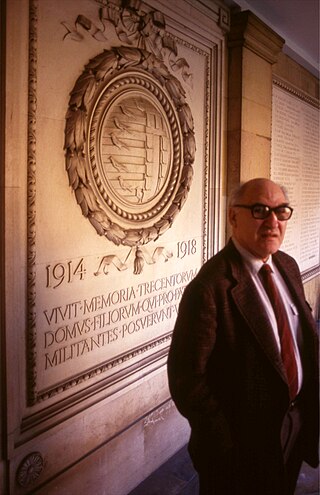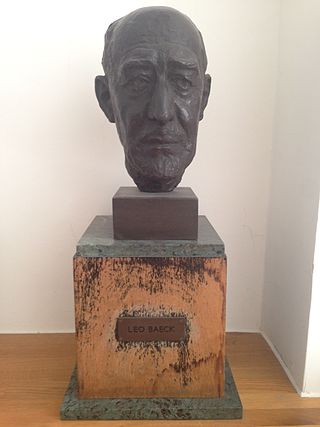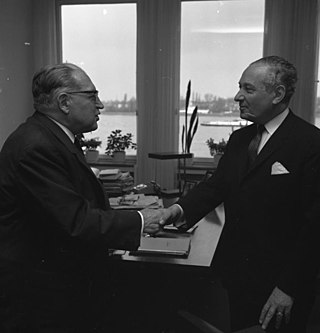Related Research Articles

The World Jewish Congress (WJC) was founded in Geneva, Switzerland in August 1936 as an international federation of Jewish communities and organizations. According to its mission statement, the World Jewish Congress' main purpose is to act as "the diplomatic arm of the Jewish people." Membership in the WJC is open to all representative Jewish groups or communities, irrespective of the social, political or economic ideology of the community's host country. The World Jewish Congress headquarters are in New York City, and the organization maintains international offices in Brussels, Belgium; Jerusalem; Paris, France; Moscow, Russia; Buenos Aires, Argentina; and Geneva, Switzerland. The WJC has special consultative status with the United Nations Economic and Social Council.

Gerhard "George" Lachmann Mosse was an American historian, who emigrated from Nazi Germany first to Great Britain and then to the United States. He was professor of history at the University of Iowa, the University of Wisconsin–Madison, and also in Israel, at the Hebrew University of Jerusalem. Best known for his studies of Nazism, he authored more than 25 books on topics as diverse as constitutional history, Protestant theology, and the history of masculinity. In 1966, he and Walter Laqueur founded The Journal of Contemporary History, which they co-edited.

The Jewish Museum Berlin was opened in 2001 and is the largest Jewish museum in Europe. On 3,500 square metres of floor space, the museum presents the history of Jews in Germany from the Middle Ages to the present day, with new focuses and new scenography. It consists of three buildings, two of which are new additions specifically built for the museum by architect Daniel Libeskind. German-Jewish history is documented in the collections, the library and the archive, and is reflected in the museum's program of events.

Stuart Elliott Eizenstat is an American diplomat and attorney. He served as the United States Ambassador to the European Union from 1993 to 1996 and as the United States Deputy Secretary of the Treasury from 1999 to 2001. For many years, and currently he has served as a partner and Senior Counsel at the Washington, D.C.–based law firm Covington & Burling and as a senior strategist at APCO Worldwide.

Leo Baeck was a 20th-century German rabbi, scholar, and theologian. He served as leader of Reform Judaism in his native country and internationally, and later represented all German Jews during the Nazi era. After the Second World War, he settled in London, in the United Kingdom, where he served as the chairman of the World Union for Progressive Judaism. In 1955, the Leo Baeck Institute for the study of the history and culture of German-speaking Jewry was established, and Baeck was its first international president. The Leo Baeck Medal has been awarded since 1978 to those who have helped preserve the spirit of German-speaking Jewry in culture, academia, politics, and philanthropy.

Nazi plunder was the stealing of art and other items which occurred as a result of the organized looting of European countries during the time of the Nazi Party in Germany. The looting of Polish and Jewish property was a key part of the Holocaust. The plundering was carried out from 1933, beginning with the seizure of the property of German Jews, until the end of World War II, particularly by military units which were known as the Kunstschutz, although most of the plunder was acquired during the war. In addition to gold, silver, and currency, cultural items of great significance were stolen, including paintings, ceramics, books, and religious treasures.

Ernst Akiba/Akiva Simon was a German-Jewish educator and religious philosopher.

Robert Weltsch was a journalist, editor and prominent Zionist.
Jüdischer Kulturbund, or Der Jüdische Kulturbund, was a Cultural Federation of German Jews, established in 1933. It hired over 1300 men and 700 women artists, musicians, and actors fired from German institutions, and grew to about 70,000 members, according to some authors. Saul Friedländer speaks of at least 180,000.

The Leo Baeck Institute, established in 1955, is an international research institute with centres in New York City, London, and Jerusalem that are devoted to the study of the history and culture of German-speaking Jewry. Baeck was its first international president. The Leo Baeck Medal has been awarded since 1978 to those who have helped preserve the spirit of German-speaking Jewry in culture, academia, politics, and philanthropy.
Secondary antisemitism is a distinct form of antisemitism which is said to have appeared after the end of World War II. Secondary antisemitism is often explained as being caused by the Holocaust, as opposed to existing in spite of it. One frequently quoted formulation of the concept, first published in Henryk M. Broder's 1986 book Der Ewige Antisemit, stems from the Israeli psychiatrist Zvi Rex, who once remarked: "The Germans will never forgive the Jews for Auschwitz." The term was coined by Peter Schönbach, a Frankfurt School co-worker of Theodor W. Adorno and Max Horkheimer, based on their critical theory.
The American Federation of Jews from Central Europe was established in New York City in 1939 to coordinate services to German-speaking Jewish refugees entering the United States. It was incorporated in 1941. The Federation offered social services, assistance with immigration paperwork, and support with education and job placement. It also put on cultural activities. The Federation focused on issues of immigration between 1939 and the end of World War II, after which it shifted towards issues of restitution. The first branch of the United Restitution Organization was founded in 1948 as part of the American Federation of Jews from Central Europe, and the federation helped distribute funds from the Jewish Restitution Successor Organization and the Jewish Trust Corporation.
Jewish Cultural Reconstruction, Inc. was an organization established by the Conference on Jewish Relations in April 1947 to collect and distribute heirless Jewish property in the American occupied zone of Germany after World War II. The organization, originally named the Commission on European Jewish Cultural Reconstruction, was originally proposed in 1944 by Theodor Gaster of the Library of Congress, and one of its cofounders.

Curt C. Silberman was a German-Jewish and American attorney, community leader, and member of Jewish organizations in both Germany and the United States. Born Kurt Leo Silbermann in Würzburg, Germany, he and his wife Else fled due to the rampant antisemitism of the Nazi era and settled in New Jersey. His legal career in the United States focused on restitution work for the victims of the Nazi government.

The Leo Baeck Institute New York (LBI) is a research institute in New York City dedicated to the study of German-Jewish history and culture, founded in 1955. It is one of three independent research centers founded by a group of German-speaking Jewish émigrés at a conference in Jerusalem in 1955. The other Leo Baeck institutes are Leo Baeck Institute Jerusalem and Leo Baeck Institute London, and the activities of all three are coordinated by the board of directors of the Leo Baeck Institute. It is also a founding partner of the Center for Jewish History, and maintains a research library and archive in New York City that contains a significant collection of source material relating to the history of German-speaking Jewry, from its origins to the Holocaust, and continuing to the present day. The Leo Baeck Medal has been awarded by the institute since 1978 to those who have helped preserve the spirit of German-speaking Jewry in culture, academia, politics, and philanthropy.

The Holocaust in Luxembourg refers to the systematic persecution, expulsion and murder of Jews in Luxembourg after its occupation and later annexation by Nazi Germany. It is generally believed that the Jewish population of Luxembourg had numbered around 3,500 before the war although many fled into France at the time of the German invasion of 10 May 1940 or in the early months of the occupation. Around 1,000 to 2,500 were murdered during the Holocaust after being deported to ghettos and extermination camps in Eastern Europe.
Michael Brenner is a German-Jewish historian who researches and publishes on the history of Jews and Israel. Brenner has authored eight books on Jewish History, which were translated into twelve languages and is the editor and co-editor of eighteen books. He holds teaching positions at both the Ludwig Maximilian University of Munich and the American University.
The Jüdische Humanitätsgesellschaft was a Zionist organization founded in Germany in 1893 by Max Bodenheimer, Heinrich Loewe, and Max Oppenheimer.The organisation was created as a response to аntisemitism. The name that was chosen for the organisation was neutral because most of the German Jews opposed Zionism. It became a group for many future leaders in German Zionism. Members included Arthur Menachem Hantke. Because the organisation had not set any clear goals except that of Jewish self-awareness, it attracted many young students.
Max Silberberg was a major cultural figure in Breslau, a German Jewish entrepreneur, art collector and patron who was robbed and murdered by the Nazis. His art collection, among the finest of its era, has been the object of numerous restitution claims.
Yossi Katz is professor emeritus at the Bar-Ilan University, an expert in historical geography. His main research interests include Jewish settlement in towns and villages in the new era, settlemental, economic, political and cultural aspects of the history of Palestine and Israel, including Zionism, land laws, kibbutzim, and communal settlements in Canada.
References
- ↑ Jewish successor organizations entry in the Jewish Virtual Library
- ↑ Staff Report, Executive Summary (December 2000). "The Jewish Restitution Successor Organization". Restitution of Victims' Assets. Presidential Advisory Commission on Holocaust Assets in the United States. Chapter V. Retrieved December 22, 2012.
- ↑ Raushenberger, Katharina. The Restitution of Jewish Cultural Objects and the Activities of Jewish Cultural Reconstruction Inc. Leo Baeck Institute Yearbook (2008) 53(1): 191-211 doi:10.1093/leobaeck/53.1.191
- ↑ Strauss, H. A. (1971). "The Immigration and Acculturation of the German Jew in the United States of America". The Leo Baeck Institute Yearbook. 16: 63–94. doi: 10.1093/leobaeck/16.1.63 .